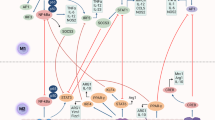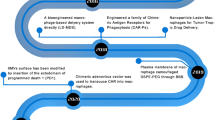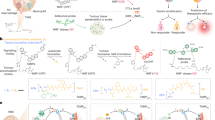Abstract
Endogenous biomarkers remain at the forefront of early disease detection efforts, but many lack the sensitivities and specificities necessary to influence disease management. Here, we describe a cell-based in vivo sensor for highly sensitive early cancer detection. We engineer macrophages to produce a synthetic reporter on adopting an M2 tumor-associated metabolic profile by coupling luciferase expression to activation of the arginase-1 promoter. After adoptive transfer in colorectal and breast mouse tumor models, the engineered macrophages migrated to the tumors and activated arginase-1 so that they could be detected by bioluminescence imaging and luciferase measured in the blood. The macrophage sensor detected tumors as small as 25–50 mm3 by blood luciferase measurements, even in the presence of concomitant inflammation, and was more sensitive than clinically used protein and nucleic acid cancer biomarkers. Macrophage sensors also effectively tracked the immunological response in muscle and lung models of inflammation, suggesting the potential utility of this approach in disease states other than cancer.
This is a preview of subscription content, access via your institution
Access options
Access Nature and 54 other Nature Portfolio journals
Get Nature+, our best-value online-access subscription
$29.99 / 30 days
cancel any time
Subscribe to this journal
Receive 12 print issues and online access
$209.00 per year
only $17.42 per issue
Buy this article
- Purchase on Springer Link
- Instant access to full article PDF
Prices may be subject to local taxes which are calculated during checkout






Similar content being viewed by others
Data availability
The data supporting the findings of this study are available within the paper and its Supplementary Information files.
Change history
18 December 2019
In the version of this Article originally published, the ORCID for Sanjiv S. Gambhir was incorrect; the correct ORCID is 0000-0002-2711-7554. This has now been amended.
References
Etzioni, R. et al. The case for early detection. Nat. Rev. Cancer 3, 243–252 (2003).
Park, S.-M. et al. Molecular profiling of single circulating tumor cells from lung cancer patients. Proc. Natl Acad. Sci. USA 113, E8379–E8386 (2016).
Phallen, J. et al. Direct detection of early-stage cancers using circulating tumor DNA. Sci. Transl. Med. 9, pii: eaan2415 (2017).
Sheridan, C. Exosome cancer diagnostic reaches market. Nat. Biotechnol. 34, 359–360 (2016).
Hori, S. S. & Gambhir, S. S. Mathematical model identifies blood biomarker–based early cancer detection strategies and limitations. Sci. Transl. Med. 3, 109ra116 (2011).
Kwong, G. A. et al. Mass-encoded synthetic biomarkers for multiplexed urinary monitoring of disease. Nat. Biotechnol. 31, 63–70 (2013).
Lin, K. Y., Kwong, G. A., Warren, A. D., Wood, D. K. & Bhatia, S. N. Nanoparticles that sense thrombin activity as synthetic urinary biomarkers of thrombosis. ACS Nano 7, 9001–9009 (2013).
Riglar, D. T. et al. Engineered bacteria can function in the mammalian gut long-term as live diagnostics of inflammation. Nat. Biotechnol. 35, 653–658 (2017).
Ronald, J. A., Chuang, H.-Y., Dragulescu-Andrasi, A., Hori, S. S. & Gambhir, S. S. Detecting cancers through tumor-activatable minicircles that lead to a detectable blood biomarker. Proc. Natl Acad. Sci. USA 112, 3068–3073 (2015).
Slomovic, S., Pardee, K. & Collins, J. J. Synthetic biology devices for in vitro and in vivo diagnostics. Proc. Natl Acad. Sci. USA 112, 14429–14435 (2015).
Biswas, S. K. Metabolic reprogramming of immune cells in cancer progression. Immunity 43, 435–449 (2015).
Murray, P. J. et al. Macrophage activation and polarization: nomenclature and experimental guidelines. Immunity 41, 14–20 (2014).
Headley, M. B. et al. Visualization of immediate immune responses to pioneer metastatic cells in the lung. Nature 531, 513–517 (2016).
Gentles, A. J. et al. The prognostic landscape of genes and infiltrating immune cells across human cancers. Nat. Med. 21, 938–945 (2015).
Colegio, O. R. et al. Functional polarization of tumour-associated macrophages by tumour-derived lactic acid. Nature 513, 559–563 (2014).
Balkwill, F. R., Capasso, M. & Hagemann, T. The tumor microenvironment at a glance. J. Cell Sci. 125, 5591 (2013).
Murdoch, C., Giannoudis, A. & Lewis, C. E. Mechanisms regulating the recruitment of macrophages into hypoxic areas of tumors and other ischemic tissues. Blood 104, 2224 (2004).
Conde, P. et al. DC-SIGN(+) macrophages control the induction of transplantation tolerance. Immunity 42, 1143–1158 (2015).
Liu, X. et al. CD47 Blockade triggers T cell-mediated destruction of immunogenic tumors. Nat. Med. 21, 1209–1215 (2015).
Tannous, B. A. Gaussia luciferase reporter assay for monitoring of biological processes in culture and in vivo. Nat. Protoc. 4, 582–591 (2009).
Rashid, O. M. et al. Is tail vein injection a relevant breast cancer lung metastasis model? J. Thorac. Dis. 5, 385–392 (2013).
Wagner, M. et al. Isolation and intravenousinjection of murine bone marrow derived monocytes. J. Vis. Exp. 94, e52347 (2014).
Quail, D. F. & Joyce, J. A. Microenvironmental regulation of tumor progression and metastasis. Nat. Med. 19, 1423–1437 (2013).
Chechlinska, M., Kowalewska, M. & Nowak, R. Systemic inflammation as a confounding factor in cancer biomarker discovery and validation. Nat. Rev. Cancer 10, 2–3 (2010).
Rivera, S. & Ganz, T. Animal models of anemia of inflammation. Semin. Hematol. 46, 351–357 (2009).
Koh, T. J. & DiPietro, L. A. Inflammation and wound healing: the role of the macrophage. Expert Rev. Mol. Med. 13, e23–e23 (2011).
Wynn, T. A. & Vannella, K. M. Macrophages in tissue repair, regeneration, and fibrosis. Immunity 44, 450–462 (2016).
Cox, G. IL-10 enhances resolution of pulmonary inflammation in vivo by promoting apoptosis of neutrophils. Am. J. Physiol. Lung Cell Mol. Physiol. 271, L566–L571 (1996).
Ulich, T. R. et al. The intratracheal administration of endotoxin and cytokines. I. Characterization of LPS-induced IL-1 and TNF mRNA expression and the LPS-, IL-1-, and TNF-induced inflammatory infiltrate. Am. J. Pathol. 138, 1485–1496 (1991).
Szpechcinski, A. et al. Cell-free DNA levels in plasma of patients with non-small-cell lung cancer and inflammatory lung disease. Br. J. Cancer 113, 476 (2015).
Castle, J. C. et al. Immunomic, genomic and transcriptomic characterization of CT26 colorectal carcinoma. BMC Genomics 15, 190 (2014).
Sadelain, M., Rivière, I. & Riddell, S. Therapeutic T cell engineering. Nature 545, 423–431 (2017).
Erdi, Y. E. Limits of tumor detectability in nuclear medicine and PET. Mol. Imaging Radionucl. Ther. 21, 23–28 (2012).
Diamandis, E. & Fiala, C. Can circulating tumor DNA be used for direct and early stage cancer detection? F1000Res. 6, 2129 (2017).
Haque, I. S. & Elemento, O. Challenges in using ctDNA to achieve early detection of cancer. Preprint at bioRxiv https://doi.org/10.1101/237578 (2017).
Fiala, C., Kulasingam, V. & Diamandis, E. P. Circulating tumor DNA for early cancer detection. J. Appl. Lab. Med. 3, 300 (2018).
Kouidhi, S., Noman, M. Z., Kieda, C., Elgaaied, A. B. & Chouaib, S. Intrinsic and tumor microenvironment-induced metabolism adaptations of T cells and impact on their differentiation and function. Front. Immunol. 7, 114 (2016).
Somasundaram, R. et al. Tumor-associated B-cells induce tumor heterogeneity and therapy resistance. Nat. Commun. 8, 607 (2017).
Vitale, M., Cantoni, C., Pietra, G., Mingari, M. C. & Moretta, L. Effect of tumor cells and tumor microenvironment on NK-cell function. Eur. J. Immunol. 44, 1582–1592 (2014).
Berger, J., Hauber, J., Hauber, R., Geiger, R. & Cullen, B. R. Secreted placental alkaline phosphatase: a powerful new quantitative indicator of gene expression in eukaryotic cells. Gene 66, 1–10 (1988).
Bonifant, C. L., Jackson, H. J., Brentjens, R. J. & Curran, K. J. Toxicity and management in CAR T-cell therapy. Mol. Ther. Oncolytics 3, 16011 (2016).
Klinkert, K. et al. Selective M2 macrophage depletion leads to prolonged inflammation in surgical wounds. Eur. Surg. Res. 58, 109–120 (2017).
Girodet, P.-O. et al. Alternative macrophage activation is increased in asthma. Am. J. Respir. Cell Mol. Biol. 55, 467–475 (2016).
Troidl, C. et al. Classically and alternatively activated macrophages contribute to tissue remodelling after myocardial infarction. J. Cell. Mol. Med. 13, 3485–3496 (2009).
Ronald, J. A., D’Souza, A. L., Chuang, H.-Y. & Gambhir, S. S. Artificial microRNAs as novel secreted reporters for cell monitoring in living subjects. PLoS ONE 11, e0159369 (2016).
Kim, S. B., Sato, M. & Tao, H. Split Gaussia luciferase-based bioluminescence template for tracing protein dynamics in living cells. Anal. Chem. 81, 67–74 (2009).
Keu, K. V. et al. Reporter gene imaging of targeted T cell immunotherapy in recurrent glioma. Sci. Transl. Med. 9, pii: eaag2196 (2017).
Smith, T. T. et al. In situ programming of leukaemia-specific T cells using synthetic DNA nanocarriers. Nat. Nanotechnol. 12, 813–820 (2017).
Pauleau, A. L. et al. Enhancer-mediated control of macrophage-specific arginase I expression. J. Immunol. 172, 7565–7573 (2004).
Acknowledgements
Funding for this work was provided by the Canary Foundation (S.S.G.) and National Cancer Institute grant R01 CA082214 (S.S.G.). A.A. has received support from the National Institutes of General Medical Sciences Medical Scientist Training Program T32 training grant GM007365, the Paul and Daisy Soros Fellowship, and the Bio-X Graduate Student Fellowship. We would like to thank P. Chu for help with tissue processing.
Author information
Authors and Affiliations
Contributions
A.A. and S.S.G conceived the project and designed all experiments. A.A., H.-Y.C., S.M., G.S.G., G.G., C.B.P, C.B., F.S., I.M. and E.R.R. conducted the experiments. A.A., A.L.D., S.P., G.S.G., C.B.P., C.B., E.A. and Z.Z. contributed to data analysis. A.A. and S.S.G. wrote the manuscript with contributions from all authors.
Corresponding author
Ethics declarations
Competing interests
A.A. and S.S.G. are co-inventors of a patent filed on the subject of this work which has been licensed by Earli, Inc. S.S.G. is a co-founder of Earli, Inc., which develops and translates early cancer detection strategies.
Additional information
Publisher’s note: Springer Nature remains neutral with regard to jurisdictional claims in published maps and institutional affiliations.
Integrated supplementary information
Supplementary Figure 1 Metabolic and cytokine drivers of Arg1 expression in macrophages.
(a) 100 mM Lactic acid induces expression of Fizz1 and Arg1 mRNA in both bone marrow-derived (left) and RAW264.7 (right) macrophages 24 h after stimulation. n = 2 independent cultures for each macrophage type (b) Arg1 protein levels exhibit a dose-dependent response to IL-4, IL-13, and TCM as measured by arginase activity assays. 25 ng/mL IL-4 p = 0.005, t = 4.78, df = 5 (n = 3 independent cultures) and Low TCM p = 0.0035, t = 5.203, df = 5 (n = 3 independent cultures) by two-tailed unpaired t-test vs. control (n = 4 independent cultures). ** indicates statistical significance at p < 0.01. Data is shown as mean ± standard error of the mean (s.e.m). BMDM, bone marrow-derived macrophage; TCM, tumor conditioned media.
Supplementary Figure 2 VivoTrack 680 labeling of RAW264.7 macrophages.
Uniform labeling of macrophages (green) was observed with 2–3 orders of magnitude of fluorescence above unstained macrophages (blue). Experiment performed twice with similar results.
Supplementary Figure 3 Flow cytometry gating strategy for macrophage sorting.
(a) Flow cytometry gating strategy for adoptively transferred (VT680+) and native (VT680-) macrophages in tumor (n = 2 independent mice), spleen (n = 5 independent mice), lung (n = 3 independent mice), and liver (n = 3 independent mice). Populations for CD11b+F4/80+ cells were well-separated in all tissues and adoptively transferred macrophages were gated based on a fluorescence minus one control. Representative plots from n = 2 independent mice shown. FMO, fluorescence minus one. (b) Average fractional makeup of administered (VT680+) vs. endogenous (VT680-) macrophages present in various tissues five days after adoptive transfer shown across n = 2 (tumor, tumor spleen) and n = 3 (healthy spleen, healthy lung, healthy liver) independent mice.
Supplementary Figure 4 Immunofluorescence of macrophage localization relative to hypoxia in CT26 tumors.
Immunofluorescence of CT26 tumors from mice injected with fluorescently labeled bone marrow-derived monocytes (bottom) reveals co-localization of macrophages (red) with regions of hypoxia (green). Immunofluorescence of a CT26 tumor from mice not injected with pimonidazole and injected with non-fluorescently labeled bone marrow-derived monocytes (top) does not yield any signal in the green or red channels confirming specificity. Images are shown at 10x magnification and scale bars measure 250 μm. Representative images from n = 2 independent mice shown for each treatment. CB640, CellBrite 640; BMDM, bone marrow-derived monocytes.
Supplementary Figure 5 pArg1-Gluc reporter plasmid map.
The pArg1-Gluc construct contains the Gaussia Dura Luciferase immediately downstream of the 3780 base pair Arg1 enhancer/promoter sequence. The construct also contains the gene for eGFP under the control of the constitutive CMV promoter for cell sorting and determining transfection efficiency.
Supplementary Figure 6 Lung microtumors in a model of metastatic breast cancer.
One week after intravenous injection of 4T1 cells, visualized disease burden remains localized to the lungs by bioluminescence imaging (left). Representative image from n = 7 independent mice shown. Ex vivo examination of the lungs also reveals non-elevated microtumors lining the lung pleura (right). Representative image from n = 2 independent mice shown. Scale bars measure 1 cm.
Supplementary Figure 7 Macrophage sensor optimization in the subcutaneous localized model of colorectal cancer.
(a) Tumor volumes measured by digital caliper are well-correlated with tumor volumes estimated by bioluminescence imaging (Pearson r = 0.9581, r2 = 0.918, two-tailed p = 0.0007, n = 7 independent mice). Dashed lines show 95% confidence interval of the linear regression. (b) The engineered macrophage sensor was unable to detect visibly necrotic tumors with volumes > 1,500 mm3 (n = 11 independent healthy mice and n = 5 independent tumor-bearing mice). (c) In detection of 50–250 mm3 localized subcutaneous tumors (n = 7 independent mice), elevated plasma Gluc compared to healthy controls (n = 4 independent mice) was apparent 24 h after macrophage sensor injection but signal declined in subsequent days in both healthy and tumor bearing mice. (d) In the same tumor model, 1 million (n = 6 independent mice) and 2 million (n = 6 independent mice) injected macrophage sensors were unable to reliably distinguish tumor bearing mice from healthy controls (n = 6 independent mice). Data is shown as mean ± s.e.m. RLU, relative luminescence units.
Supplementary Figure 8 Bone marrow-derived monocyte purity and electroporation efficiency.
(a) Harvested BMDMs exhibited 96.3% purity by F4/80 staining after 5 days of differentiation in 20 ng/mL murine macrophage colony stimulating factor. Experiment performed 3 times with similar results. (b) BMDMs were electroporated with the pArg1-Gluc reporter plasmid with an efficiency of > 80% and viability ~60% as quantified by flow cytometry. Experiment performed 3 times with similar results.
Supplementary Figure 9 The effect of intravenously injected macrophage sensor on tumor progression.
Intravenous injection of BMDM sensor in subcutaneous tumor-bearing mice (n = 4) leads to an initial regression (Day 4, p = 0.0579, t = 2.451, df = 5, two-tailed unpaired t-test) of tumor volume relative to vehicle injected mice (n = 3) followed by resumption of exponential growth. Left plot shows growth of individual tumors and right plot shows average tumor volumes. Mice were sacrificed upon tumors exceeding 15 mm in any dimension and average tumor volumes in right plot are only shown for time points in which all mice in a group were still alive. Data in left panel shown as mean ± s.e.m. BMDM, bone marrow-derived macrophage.
Supplementary Figure 10 Deletion mutation limit of detection with locked nucleic acid probes.
Real-time qPCR amplification plots of CT26 and wildtype Balb/c genomic DNA show that the chromosome 7 (left) and 19 (right) deletions can be detected at allele frequencies of 0.1 and 1% respectively. Each condition is shown in triplicate. RFU, relative fluorescence units; AF, allele frequency.
Supplementary information
Supplementary Figures and Text
Supplementary Figures 1–10 and Supplementary Table 1.
Rights and permissions
About this article
Cite this article
Aalipour, A., Chuang, HY., Murty, S. et al. Engineered immune cells as highly sensitive cancer diagnostics. Nat Biotechnol 37, 531–539 (2019). https://doi.org/10.1038/s41587-019-0064-8
Received:
Accepted:
Published:
Issue Date:
DOI: https://doi.org/10.1038/s41587-019-0064-8
This article is cited by
-
Engineered serum markers for non-invasive monitoring of gene expression in the brain
Nature Biotechnology (2024)
-
Camouflaging attenuated Salmonella by cryo-shocked macrophages for tumor-targeted therapy
Signal Transduction and Targeted Therapy (2024)
-
Biomolecular sensors for advanced physiological monitoring
Nature Reviews Bioengineering (2023)
-
CRISPR-Cas-amplified urinary biomarkers for multiplexed and portable cancer diagnostics
Nature Nanotechnology (2023)
-
Functional Potassium Channels in Macrophages
The Journal of Membrane Biology (2023)



